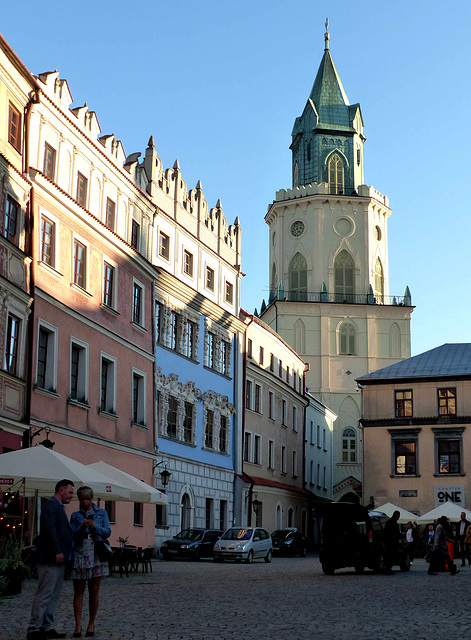Location
See also...
Keywords
Authorizations, license
-
Visible by: Everyone -
All rights reserved
-
37 visits
Lublin - Wieża Trynitarska


A fortress of a regional tribe is attested here. After its destruction, Casimir I the Restorer, son of Mieszko II Lambert, had a castle built here.
In 1205 Roman of Volhynia unsuccessfully besieged the castle. In 1241 Lublin was destroyed by the Tatars. In 1244 the place was conquered by Lithuanians, in the same year, Daniel Romanovich of Galicia conquered and fortified it.
Under the protection of the castle, the settlement developed into a trade center. In 1317 it received the town charter. In the 15th and 16th centuries, the town grew rapidly. The largest trade fairs of the Polish-Lithuanian community were held in Lublin. In the 16th century, the parliaments (Sejm) of the Kingdom of Poland were held in Lublin several times. At one of the most important ones, the "Union of Lublin" was proclaimed in 1569, uniting Poland and Lithuania. After the capital was moved from Krakow to Warsaw in 1596, Lublin was located away from the main traffic and trade routes. As a result, there was an economic and cultural decline.
In the course of the Counter-Reformation, the Protestants were forcibly expelled from the city in 1631, so many merchants emigrated. In 1655 Cossacks sacked the town and the following year Swedish soldiers. After the Northern War, the reconstruction of the town began. Stanislaus II August Poniatowski allowed Protestants to settle in the city again. At this time, a significant Jewish community was also established. The Jews were an important part of life in the city until the Holocaust. During WWII they were deported by Nazi Germany to the infamous Lublin Ghetto and eventually murdered.
After the Third Partition of Poland in 1795, Lublin was part of the Austrian Empire, after the Austro-Polish War of 1809 it was part of the short-lived Polish Duchy of Warsaw, and in 1815 it was part of Congress Poland as part of the Russian partition of Poland. Russian rule ended in 1915 when the city was occupied by German and Austro-Hungarian armies. After the end of World War I, the Provisional People's Government of the Republic of Poland - the first government of independent Poland - was based in Lublin for a short time.
-
The Trinity Tower is also called the Trinity Gate because it was originally the monastery gate of a Jesuit college. In 1627 it was raised and used as a bell tower. After the abolition of the Jesuit order, it passed into the hands of the Trinitarians, but they did not maintain the building well, so in 1818 it became the property of the city.
The Italian-born architect Tower Antonio Corazzi designed the tower in the neo-Gothic style. It was severely damaged during WWII and rebuilt in 1945-1952.
In 1205 Roman of Volhynia unsuccessfully besieged the castle. In 1241 Lublin was destroyed by the Tatars. In 1244 the place was conquered by Lithuanians, in the same year, Daniel Romanovich of Galicia conquered and fortified it.
Under the protection of the castle, the settlement developed into a trade center. In 1317 it received the town charter. In the 15th and 16th centuries, the town grew rapidly. The largest trade fairs of the Polish-Lithuanian community were held in Lublin. In the 16th century, the parliaments (Sejm) of the Kingdom of Poland were held in Lublin several times. At one of the most important ones, the "Union of Lublin" was proclaimed in 1569, uniting Poland and Lithuania. After the capital was moved from Krakow to Warsaw in 1596, Lublin was located away from the main traffic and trade routes. As a result, there was an economic and cultural decline.
In the course of the Counter-Reformation, the Protestants were forcibly expelled from the city in 1631, so many merchants emigrated. In 1655 Cossacks sacked the town and the following year Swedish soldiers. After the Northern War, the reconstruction of the town began. Stanislaus II August Poniatowski allowed Protestants to settle in the city again. At this time, a significant Jewish community was also established. The Jews were an important part of life in the city until the Holocaust. During WWII they were deported by Nazi Germany to the infamous Lublin Ghetto and eventually murdered.
After the Third Partition of Poland in 1795, Lublin was part of the Austrian Empire, after the Austro-Polish War of 1809 it was part of the short-lived Polish Duchy of Warsaw, and in 1815 it was part of Congress Poland as part of the Russian partition of Poland. Russian rule ended in 1915 when the city was occupied by German and Austro-Hungarian armies. After the end of World War I, the Provisional People's Government of the Republic of Poland - the first government of independent Poland - was based in Lublin for a short time.
-
The Trinity Tower is also called the Trinity Gate because it was originally the monastery gate of a Jesuit college. In 1627 it was raised and used as a bell tower. After the abolition of the Jesuit order, it passed into the hands of the Trinitarians, but they did not maintain the building well, so in 1818 it became the property of the city.
The Italian-born architect Tower Antonio Corazzi designed the tower in the neo-Gothic style. It was severely damaged during WWII and rebuilt in 1945-1952.
Berny, Ulrich John, Alexander Prolygin, Andy Rodker have particularly liked this photo
- Keyboard shortcuts:
Jump to top
RSS feed- Latest comments - Subscribe to the comment feeds of this photo
- ipernity © 2007-2024
- Help & Contact
|
Club news
|
About ipernity
|
History |
ipernity Club & Prices |
Guide of good conduct
Donate | Group guidelines | Privacy policy | Terms of use | Statutes | In memoria -
Facebook
Twitter

Sign-in to write a comment.